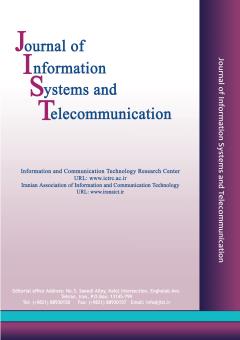Designing a Hybrid Algorithm that Combines Deep Learning and PSO for Proactive Detection of Attacks in IoT Networks
Subject Areas : Machine learning
Zahra Bakhshali
1
![]() ,
Alireza Pourebrahimi
2
*
,
Alireza Pourebrahimi
2
*
![]() ,
Ahmad Ebrahimi
3
,
Ahmad Ebrahimi
3
![]() ,
Nazanin Pilevari
4
,
Nazanin Pilevari
4
![]()
1 - Department of Information Technology Management, SRC, Islamic Azad University, Tehran, Iran
2 - Department of Industrial Management, Karaj Branch, Islamic Azad University, Alborz, Iran
3 - Department of Industrial and Technology Management, SRC, Islamic Azad University, Tehran, Iran
4 - Department of Industrial Management, West Tehran Branch, Islamic Azad University, Tehran, Iran
Keywords: Deep Learning Algorithms, Internet of Things, IoT Attacks, PSO algorithm,
Abstract :
As a result, with the establishment of Internet of Things (IoT) at a booming pace, the demand for effective, green security systems to detect cyber-attacks is escalating. Despite thorough investigation in this domain, the heterogeneous nature and multifaceted characteristic of IoT data make successful attack detection a challenging task. This paper introduces a new method for enhancing IoT attack detection through a hybrid deep learning model (CNN-GRU-LSTM) integrated with Particle Swarm Optimization (PSO) for hyperparameter optimization. This methodology consists of different steps, starting with a CSV (Comma Separated Values) file to use it as the dataset, performing different data science operations like feature selection, calculating weights to balance the class for learning the model, etc. A hybrid CNN-GRU-LSTM model is subsequently established and trained with the integration of the merit of each algorithm: CNN for spatial feature abstraction, GRU for effectiveness in managing the sequential information, and LSTM for discovering the long-range dependencies. The hyperparameters of the PSO algorithm are optimized to find the best combination of features/parameters to improve detection performance and efficiency. The results show remarkable accuracy and efficiency improvements over traditional methods. H. PSO for Optimizing Hybrid Deep Learning Architecture The gainful approach to building deep neural networks for IoT frameworks is through PSO based improvements. The results help to advance a realm of research work in IoT security and lay a grouped foundation for further work in optimizing attack detection models with different machine learning algorithms and optimization approaches.
[1] M. Haras and T. Skotnicki, “Thermoelectricity for IoT – A review,” 2018. doi: 10.1016/j.nanoen.2018.10.013.
[2] A. Ullah, N. Javaid, O. Samuel, M. Imran, and M. Shoaib, “CNN and GRU based Deep Neural Network for Electricity Theft Detection to Secure Smart Grid,” in 2020 International Wireless Communications and Mobile Computing, IWCMC 2020, 2020. doi: 10.1109/IWCMC48107.2020.9148314.
[3] A. M. Banaamah and I. Ahmad, “Intrusion Detection in IoT Using Deep Learning,” Sensors, vol. 22, no. 21, 2022, doi: 10.3390/s22218417.
[4] C. U. Om Kumar, S. Marappan, B. Murugeshan, and P. M. R. Beaulah, “Intrusion Detection Model for IoT Using Recurrent Kernel Convolutional Neural Network,” Wirel Pers Commun, vol. 129, no. 2, 2023, doi: 10.1007/s11277-022-10155-9.
[5] M. A. Khan, “HCRNNIDS: Hybrid convolutional recurrent neural network-based network intrusion detection system,” Processes, vol. 9, no. 5, 2021, doi: 10.3390/pr9050834.
[6] A. Dushimimana, T. Tao, R. Kindong, and A. Nishyirimbere, “Bi-directional Recurrent Neural network for Intrusion Detection System (IDS) in the internet of things (IoT),” International Journal of Advanced Engineering Research and Science, vol. 7, no. 3, 2020, doi: 10.22161/ijaers.73.68.
[7] N. W. Khan et al., “A hybrid deep learning-based intrusion detection system for IoT networks,” Mathematical Biosciences and Engineering, vol. 20, no. 8, 2023, doi: 10.3934/mbe.2023602.
[8] S. M. Jagannath, R. B. Mohite, M. K. Gupta, and O. S. Lamba, “Implementation of Machine Learning and Deep Learning for Securing the Devices in IOT Systems,” Indian J Sci Technol, vol. 16, no. 9, pp. 640–647, May 2023, doi: 10.17485/IJST/v16i9.99.
[9] T. A. Tang, L. Mhamdi, D. McLernon, S. A. R. Zaidi, and M. Ghogho, “Deep Recurrent Neural Network for Intrusion Detection in SDN-based Networks,” in 2018 4th IEEE Conference on Network Softwarization and Workshops, NetSoft 2018, 2018. doi: 10.1109/NETSOFT.2018.8460090.
[10] S. A. Alabady, F. Al-Turjman, and S. Din, “A Novel Security Model for Cooperative Virtual Networks in the IoT Era,” Int J Parallel Program, vol. 48, no. 2, 2020, doi: 10.1007/s10766-018-0580-z.
[11] A. A. Alahmadi et al., “DDoS Attack Detection in IoT-Based Networks Using Machine Learning Models: A Survey and Research Directions,” 2023. doi: 10.3390/electronics12143103.
[12] L. Xiao, X. Wan, X. Lu, Y. Zhang, and D. Wu, “IoT Security Techniques Based on Machine Learning: How Do IoT Devices Use AI to Enhance Security?,” IEEE Signal Process Mag, vol. 35, no. 5, 2018, doi: 10.1109/MSP.2018.2825478.
[13] M. Jain, V. Saihjpal, N. Singh, and S. B. Singh, “An Overview of Variants and Advancements of PSO Algorithm,” 2022. doi: 10.3390/app12178392.
[14] J. Fang, W. Liu, L. Chen, S. Lauria, A. Miron, and X. Liu, “A Survey of Algorithms, Applications and Trends for Particle Swarm Optimization,” International Journal of Network Dynamics and Intelligence, 2023, doi: 10.53941/ijndi0201002.
[15] A. Aribisala, M. S. Khan, and G. Husari, “Feed-Forward Intrusion Detection and Classification on a Smart Grid Network,” in 2022 IEEE 12th Annual Computing and Communication Workshop and Conference, CCWC 2022, 2022. doi: 10.1109/CCWC54503.2022.9720898.
[16] W. H. Lin, P. Wang, B. H. Wu, M. S. Jhou, K. M. Chao, and C. C. Lo, “Behaviorial-Based Network Flow Analyses for Anomaly Detection in Sequential Data Using Temporal Convolutional Networks,” in Lecture Notes on Data Engineering and Communications Technologies, vol. 41, 2020. doi: 10.1007/978-3-030-34986-8_12.
[17] M. Chattopadhyay, “Modelling of intrusion detection system using artificial intelligence—evaluation of performance measures,” Studies in Fuzziness and Soft Computing, vol. 319, 2015, doi: 10.1007/978-3-319-12883-2_11.

